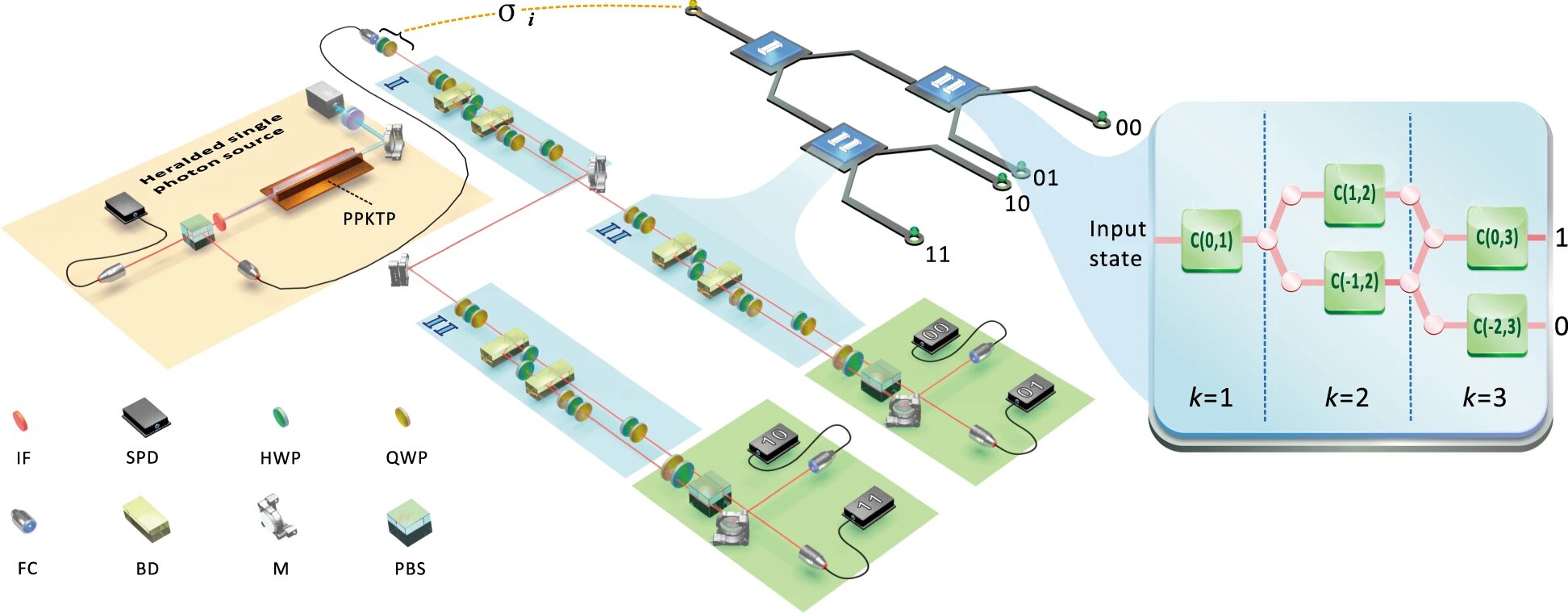Scientists propose revolution in complex systems modeling with quantum technologies
by University of Manchester

Photonic implementation of quantum models of PMD processes. We use a photonic setup to implement our quantum models. The orange region highlights the state preparation module, where two photons with a central wavelength of 808nm are generated via pumping a PPKTP crystal with temperature stabilized to around 35 °C through a type-II spontaneous parametric down-conversion process. One of the photons passes through a single-mode fiber and is prepared with an initial memory state encoded in its polarization, while the other is used as a trigger. The blue regions show the simulation module that carries out the evolution, encoding outputs into the photon path and updating the memory by rotating its polarization (see Methods for details). After evolving two timesteps, the photon is passed into the tomography module (green region), where the output statistics are produced by photodetection counts, and the polarization is measured to tomographically reconstruct the final memory state. The optical components shown comprise PBS, polarizing beamsplitter; M, mirror; IF, interference filter; QWP, quarter-wave plate; HWP, half-wave plate; FC, fiber coupler; BD, beam displacer; SPD, single photon detector. Credit: Nature Communications (2023). DOI: 10.1038/s41467-023-37555-0
Scientists have made a significant advancement with quantum technologies that could transform complex systems modeling with an accurate and effective approach that requires significantly reduced memory.
Complex systems play a vital role in our daily lives, whether that be predicting traffic patterns, weather forecasts, or understanding financial markets. However, accurately predicting these behaviors and making informed decisions relies on storing and tracking vast information from events in the distant past—a process which presents huge challenges.
Current models using artificial intelligence see their memory requirements increase by more than a hundredfold every two years and can often involve optimization over billions—or even trillions—of parameters. Such immense amounts of information lead to a bottleneck where we must trade-off memory cost against predictive accuracy.
A collaborative team of researchers from The University of Manchester, the University of Science and Technology of China (USTC), the Centre for Quantum Technologies (CQT) at the National University of Singapore and Nanyang Technological University (NTU) propose that quantum technologies could provide a way to mitigate this trade-off.
The team have successfully implemented quantum models that can simulate a family of complex processes with only a single qubit of memory—the basic unit of quantum information—offering substantially reduced memory requirements.
Unlike classical models that rely on increasing memory capacity as more data from past events are added, these quantum models will only ever need one qubit of memory.
The development, published in the journal Nature Communications, represents a significant advancement in the application of quantum technologies in complex system modeling.
Dr. Thomas Elliott, project leader and Dame Kathleen Ollerenshaw Fellow at The University of Manchester, said, "Many proposals for quantum advantage focus on using quantum computers to calculate things faster. We take a complementary approach and instead look at how quantum computers can help us reduce the size of the memory we require for our calculations."
"One of the benefits of this approach is that by using as few qubits as possible for the memory, we get closer to what is practical with near-future quantum technologies. Moreover, we can use any extra qubits we free up to help mitigate against errors in our quantum simulators."
The project builds on an earlier theoretical proposal by Dr. Elliott and the Singapore team. To test the feasibility of the approach, they joined forces with USTC, who used a photon-based quantum simulator to implement the proposed quantum models.
The team achieved higher accuracy than is possible with any classical simulator equipped with the same amount of memory. The approach can be adapted to simulate other complex processes with different behaviors.
Dr. Wu Kang-Da, post-doctoral researcher at USTC and joint first author of the research, said, "Quantum photonics represents one of the least error-prone architectures that has been proposed for quantum computing, particularly at smaller scales. Moreover, because we are configuring our quantum simulator to model a particular process, we are able to finely-tune our optical components and achieve smaller errors than typical of current universal quantum computers."
Dr. Chengran Yang, Research Fellow at CQT and also joint first author of the research, added, "This is the first realization of a quantum stochastic simulator where the propagation of information through the memory over time is conclusively demonstrated, together with proof of greater accuracy than possible with any classical simulator of the same memory size."
Beyond the immediate results, the scientists say that the research presents opportunities for further investigation, such as exploring the benefits of reduced heat dissipation in quantum modeling compared to classical models. Their work could also find potential applications in financial modeling, signal analysis and quantum-enhanced neural networks.
Next steps include plans to explore these connections, and to scale their work to higher-dimensional quantum memories.
More information: Kang-Da Wu et al, Implementing quantum dimensionality reduction for non-Markovian stochastic simulation, Nature Communications (2023). DOI: 10.1038/s41467-023-37555-0
Journal information: Nature Communications
